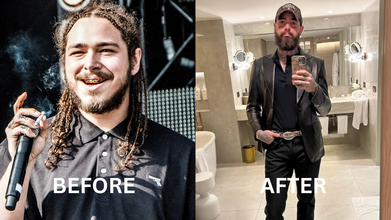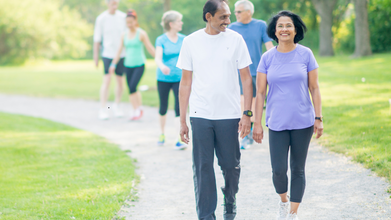- Health Conditions A-Z
- Health & Wellness
- Nutrition
- Fitness
- Health News
- Ayurveda
- Videos
- Medicine A-Z
- Parenting
10 Minutes, Daily, Every Week: 8 Yoga Poses To Stay Fit And Healthy

(Credit-Canva)
Yoga has the ability to set the tone of your day. We see people who wake up super early, do a morning routine and squeeze in some yoga. This may seem like a hectic schedule to many, but exercising early in the morning has shown to be good for the mental as well as physical well-being of people. Experts explain that doing yoga every morning increases your energy, improves mental clarity, helps you reduce stress as well as ensure your physical well-being.
If you are worried about spending a dedicated time doing yoga, like an hour or so, you do not have to worry. Even spending 10 minutes, fully focused yoga can help you immensely. If you are doing these poses with guided videos, make sure you are not pushing yourself too hard, and proceed with caution. If you feel any odd discomfort, make sure you visit a healthcare professional just to be safe.
Child's Pose
Begin in Child's Pose, bringing your big toes together and knees wide for a comfortable stretch. Extend your arms forward, lifting onto your fingertips to deepen the stretch in your shoulders and armpits. Focus on expanding your ribcage with each inhale and relaxing your arms closer to the mat with each exhale, using your breath to settle into the pose.
Cat-Cow
Transition to Tabletop position, bringing your knees closer together. Flow through three rounds of Cat-Cow, arching your back on the inhale and rounding it on the exhale. This movement helps to gently mobilize and warm up your spine.
Leg Lifts and Variations
From Tabletop, lift your right leg, knee, and toes towards the ceiling on the inhale, and bring your knee to your nose on the exhale. Repeat twice, engaging your core. For an added challenge, lift your right leg again and reach back with your left hand to grab your right foot, deepening the backbend and stretching your left shoulder.
Modified Side Plank
With your right leg lifted, return your left hand to the mat, straighten your right leg, and roll onto the inner edge of your right foot into a modified Side Plank. Perform five toe taps, lifting and lowering your right leg, then bend your right knee to grab your right foot, deepening the backbend and shoulder stretch. Repeat the sequence on the left side.
Downward-Facing Dog
Move into Downward-Facing Dog, lifting your hips up and back, bending your knees as needed to lengthen your spine. From Down Dog, lift your right leg, bend your knee, and open your hip in Scorpion Dog.
Warrior 2 and Triangle Pose
Step your right foot forward into Warrior 2, grounding through your back foot and bending your front knee. Transition into Triangle Pose, straightening your right leg and reaching your right arm forward, then down, while your left arm extends upward. Explore variations to deepen the pose and strengthen your obliques.
Low Lunge and Quad Stretch
From Triangle Pose, move into Low Lunge, placing your back knee on the mat. Optionally, add a quad stretch by reaching back with your right hand to grab your left foot, pulling your heel towards your glutes. Repeat the sequence on the left side, then move back to Downward-Facing Dog.
Child's Pose and Seated Meditation
Return to Child's Pose, resting your hips towards your heels and extending your arms forward. Take five deep breaths, reflecting on your intention for the day. Transition into a comfortable seated position for a short meditation. Close your eyes, relax your shoulders, and soften your facial muscles. Focus on your breath and your intention for the day, grounding yourself before moving forward.
How Post Malone Lost 55lbs Just By Cutting Soda And Ditching Junk

Credits: Canva
"I'm excited for this next chapter in my life, I'm the happiest I've ever been, and for since I could remember I was sad," said Post Malone as he talked about his journey of losing 55 pounds. He went from 240 lbs to 185 lbs, he revealed at The Joe Rogan Experience Podcast. His inspiration? His daughter. He said that he is focused more on his health since becoming a father.
"It is definitely made me take better care of myself. I want to be around to see her go and do kick-*ss stuff. And before, you know, I was really drinking a lot and smoking a lot and stuff. I kind of took everything and toned it down a little bit and, you know, doing my best and really got my weight going," he said.
His weight loss journey started after he welcomed his daughter in May 2022, and on April 20233, he shared on his Instagram that post becoming a father he is now prioritizing his health.
How Did Post Malone Lose So Much Weight?
He said it is simple, he decided to "kick soda and start eating better". He also is trying to cut down his smokes and brews or give up completely, which is taking time.
On his Instagram post, he wrote: "I've had a lot of people ask me about my weight loss and I'd suppose, performance on stage. I'm having a lot of fun performing, and have never felt healthier. I guess dad life kicked in and I decided to kick soda and start eating better so I can be around for a long time for this little angel. Next up is smokes and brews, but I like to consider myself a patient man... lol!"
While his fans were initially concerned about his weight loss, he reassured them that his "brain is in a super dope place" and he was "the happiest" he has ever been in a long time.
When he made his appearance in June 2024, on The Joe Rogan Experience Podcast, he said that his fans in fact, thought, that he started using drugs, due to his drastic weight loss. This is why he posted on Instagram to deny those allegations. “I remember, whenever I started losing my weight, everybody was like, ‘Hey, this is what meth looks like,’ and I started dancing on stage and having fun and having more energy and just enjoying life again, you know what I mean,” he told host Joe Rogan. “Like I mentioned, I was s***** for a long time, but I had my baby and I’m in a great f****** spot and then the first thing that happens is like, ‘Oh he’s on f****** drugs.’"
However, Malone has confirmed that he is not "any hard drugs".
What Helped Malone Lose 55 Pounds?
In an appearance on The Howard Stern Show in October 2023, Malone said that he has not been on weight loss medication, rather he is now making better food choices.
Earlier, whenever he was on tour, he would go for junk, but now, he has made a deliberate choice to eat "grilled chicken" "carrots" with a "little bit of white rice with hot sauce". He said he was blown away to find out that hot sauce has no calories.
He also shared that he has cut out fried food and pizza. He shared that he would previously eat a lot of junk while on tour, especially because those places were open at 2 am after a show. However, when he made those small dietary changes, he lost 20 pounds, which made him think "let's keep building".
He also shared that he started cutting down on his soda intake. However, he would occasionally reward himself with one after a show.
He also showed off his weight loss in an August 2023 Instagram post on a mirror selfie and wrote: "Introducing Viceroy Chungus VonBattlepass, i love you," in caption.
Cannot Hit 10,000 Steps A Day? A Short Stroll Too Could Make You Healthy

Credits: Canva
For years, the idea of walking 10,000 steps a day has been treated like universal fitness wisdom, however, a recent study reveals that even a short stroll too could help you stay healthy.
From fitness trackers to morning-walk groups, the number has been repeated so often that many people believe it is a scientifically proven rule. The truth is far simpler and far more encouraging. New research shows that you do not need anywhere near 10,000 steps to improve your health. In fact, even a small amount of regular movement can dramatically lower your risk of heart disease and early death.
What Recent Research Reveals
A new study published in the British Journal of Sports Medicine examined how step counts influence longevity and heart health, particularly in older adults. The findings were surprisingly optimistic. Scientists discovered that walking as few as 4,000 steps in a day, even if you manage this number only one or two days a week, can reduce the risk of death by 26 percent. It can also lower the risk of heart disease by 27 percent when compared to those who barely moved.
The benefits became even more striking when participants achieved the 4,000 step target on more than three days per week. In that group, mortality dropped by more than 40 percent and the risk of heart issues fell by 27 percent. These numbers show that moderate, regular walking has powerful protective effects on long-term health.
How Many Steps Do You Really Need
The study also explored whether aiming for higher step counts brings additional benefits. Researchers found that walking around 7,000 steps a day provides a slight extra advantage when it comes to living longer. However, it does not significantly change cardiovascular outcomes. This means that hitting 4,000 steps is already enough for meaningful protection, especially for older adults or people who are unable to reach higher counts.
Interestingly, the study also revealed that the number of days you walk matters far less than the total steps collected throughout the day. When scientists adjusted for total daily steps, the link between how many days people walked and their health results disappeared. The real takeaway is this: what matters most is how much you move overall, not whether you meet a daily or weekly quota.
Why Consistency Matters More Than Intensity
Walking is one of the simplest forms of movement, yet its benefits are remarkably wide-ranging. It is gentle, low impact and accessible to almost everyone. Regular brisk walking has been shown to improve heart health, support weight management, boost mental well-being and improve mobility. These improvements occur because consistency helps the body adapt, even when the total effort seems small.
For older adults, or for anyone returning to activity after a long pause, this consistency is especially important. Small, steady efforts accumulate and gradually build up stamina. Over time, this reduces the risk of chronic disease and enhances overall fitness without stressing the joints.
Tips To Make Walking A Sustainable Habit
If you want to enjoy the health benefits of walking, the key is to stay consistent rather than chase big numbers. A few practical tips can help you build a routine that feels realistic and enjoyable.
Start slowly
If you have been inactive for a while, begin with five to ten minutes of walking at a comfortable pace. Gradually increase your duration and distance over several weeks. This prevents strain and reduces the risk of giving up too soon.
Set achievable goals
Aim for manageable targets such as walking 20 to 40 minutes three days a week. Once this feels comfortable, you can add more time or increase your frequency if you wish.
Adjust your routine when life gets busy
If you are traveling or have long work hours, try breaking your walks into shorter chunks. A few five to ten minute walks throughout the day can help you stay on track.
Do not let the weather stop you
When outdoor conditions are not ideal, choose indoor spaces such as malls, gyms, community centers or even long corridors at home or work.
Add variety to your routes
Different routes help fight monotony and make walking more enjoyable. Rotate between parks, neighborhoods or indoor spaces to keep things fresh.
10,000 Steps Cannot Undo The Damage Caused By A 9-Hour Desk Job, According To Doctor

Credits: Canva
For many people, completing a daily step goal feels like a sign of an active lifestyle. Fitness trackers, wellness challenges and social media trends have popularized the belief that 10,000 steps can undo the negative effects of long hours spent at a desk. However, vascular experts warn that this assumption is misleading. Prolonged sitting continues to damage the veins and circulation even if one walks later in the day.
Vascular Surgeon and Varicose Vein Specialist Dr Sumit Kapadia recently posted a video on his Instagram channel explaining why step counts alone cannot protect vascular health. He said this is something he tells his patients almost every day. Even if someone completes their step goal in the evening, the body has already endured hours of immobility that strain the veins.
According to Dr Kapadia, circulation does not depend on how much a person walks in total. Instead, it depends on how frequently they move. Long stretches of sitting from nine in the morning to seven in the evening cause blood to stagnate in the legs. This stagnation triggers a progressive cycle: vein valve weakness, swelling, varicose veins and, over time, an increased risk of developing blood clots.
Why Sitting for Long Hours Harms the Veins
When a person sits for too long, blood flow in the legs slows down. Veins must work harder to pump blood upward toward the heart, especially against gravity. The longer blood pools in the lower legs, the more pressure builds inside the veins. Over time, this weakens the valves that keep blood moving in the right direction.
Dr Kapadia explained that even a healthy step count cannot reverse ten hours of immobility. The veins experience stress and pressure throughout the day, and walking later does not undo the hours of stagnation already endured.
People with sedentary jobs, long commutes or limited movement throughout the day are especially at risk. Additional factors like being overweight, having a family history of venous disease, or standing for long hours without moving can worsen the impact.
Movement Frequency Matters More Than Step Count
According to Dr Kapadia, vascular health depends more on how often you move than how much you walk. The solution is not long-distance jogging or intense workouts after work, but small, consistent breaks during the day.
He offered a simple rule for preventing vein damage:
- Get up every 45 to 60 minutes.
- Stretch briefly to activate muscles.
- Walk for at least two minutes.
- Move your calf muscles, which act as the body’s “peripheral heart.”
Calf muscles play a major role in circulating blood back to the heart. When they contract, they push blood upward from the legs. But when they remain still for long periods, this pumping mechanism weakens. Small actions like ankle rotations, standing on tiptoes or short hallway walks can activate this pump and support vein health.
Small Breaks Make a Big Difference
Dr Kapadia emphasized that the veins do not need marathons. They need movement. Tiny breaks spread across the day help prevent swelling, heaviness, varicose veins and long-term complications such as deep vein thrombosis.
In a world where work, travel and digital life keep people sitting for most of the day, this message is more relevant than ever. Steps matter, but frequency matters far more. The key to healthy veins is simple: move often.
© 2024 Bennett, Coleman & Company Limited

